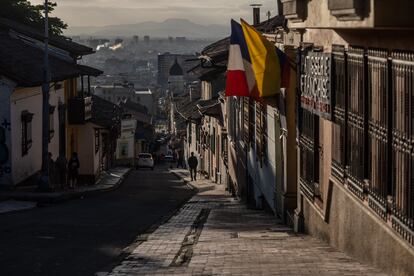Bogotá's pedestrians forced to navigate ‘spitting’ sidewalks
Poorly maintained walkways in some of the Colombian capital’s most exclusive neighborhoods reflect decades of neglect by public officials

One misstep can spell danger for pedestrians in Bogotá. In a funny scene from Disney’s animated film, Encanto, the floor tiles of the Madrigal house take on a life of their own. But in real life, it happens every day and no one is laughing about the protruding paving blocks tripping up pedestrians on the downtown sidewalks of Colombia’s capital city.
Alix Rojas is 73 years old and doesn’t feel very safe anymore when she takes her daily walks around the neighborhood, and it’s not because she’s worried about being mugged. “It’s because the concrete blocks on the sidewalks come loose after it rains,” she said. She recently injured herself after falling one morning when she went out to buy some groceries, and returned home limping in pain.
“You take a step and it’s good and firm, but that makes the next piece of sidewalk pop up,” said Rojas. “And that’s what happened... I fell down with everything I was carrying. A stumble on a jumping sidewalk.” She wasn’t able to reach out and break her fall. “My hands, hips and legs were all bruised. Fortunately, my face was fine. There were no fractures, but the pain and bruises lasted several days,” said Rojas.
Navigating the sidewalks in some parts of Bogotá is a gamble, especially on rainy days. It’s common to see pedestrians dodging the so-called “spitting” pavers on the walkways of many residential and commercial areas. “Getting dirty is the least of your worries. Many people have seriously hurt themselves walking on those loose blocks. It’s a daily mishap that has become part of life in Bogotá,” said Diego Laserna, a city council member who has tried to get the attention of public officials by painting some damaged sidewalks like the classic Minesweeper game board.
The problem is more than 20 years old. Paving walkways with concrete blocks and cobblestones was part of an initiative by former Mayor Enrique Peñalosa to reclaim public spaces for pedestrian use. A technical plan that was drawn up and ratified in 2000 is still in place today, although it has been regularly updated. Two decades later, an initiative designed to provide more space for people to walk safely is now forcing pedestrians to avoid sidewalks. The installation of low-quality paving blocks along the main TransMilenio bus routes by the Peñalosa administration was roundly denounced, and the ensuing scandal prompted multiple investigations and cost the city millions in repairs.
The city’s sidewalks are also going to need significant investment. According to the latest study by Bogotá's public works department (IDU), more than half of the 290 million square feet (27 million square meters) of sidewalks were in fair-to-poor condition in 2018. This year, the city budgeted more than $78 million for repairing sidewalks, bike paths, and pedestrian and vehicular bridges. But according to the IDU, this amount still falls short of meeting the need. “Despite all the maintenance efforts, the evident deterioration is getting worse due to several factors, including vandalism and normal wear and tear,” said the IDU.
Many wear sneakers for more stability as they are forced to choose every day between walking on broken sidewalks or on the sides of streets with moving vehicles
Alberto Cuellar, a civil engineer with the University of the Andes in Bogotá, explained that the sidewalk and TransMilenio defects are similar. “It’s called ‘pumping,’ and it happens because of bad seals between the joints that allow water to seep underneath the blocks and erode the underlying base of granular material,” said Cuellar. “After a while, there’s no support underneath the blocks, so when you step on one side, the other side pops up and splashes or ‘spits’ the accumulated water at the pedestrian, and sometimes the block just breaks.” Cuellar doesn’t believe that these public spaces are being properly monitored and maintained.
The pedestrian walkway design was a Lego-style modular system that was supposed to offer a practical and uniform construction process. All the high-traffic roads in the northern part of Bogotá were prioritized for repaving. But what seemed like a good idea at the time is now a major headache. Mario Hurtado, a geographer and urban planning specialist, says that the design was not appropriate for Bogotá's climate, where it rains regularly for six or seven months. “A different type of sidewalk would be better – one that is suited to the climate and the sedimentary soil of Bogotá, which is constantly sinking. A sidewalk system that tries to fit together puzzle pieces that aren’t solidly embedded in the ground is not ideal for a rainy climate,” said Hurtado.
Complaints are common on social media and in daily conversations, but nothing seems to move authorities to reevaluate a design that has been replicated in other parts of the city. “It’s terrible. It’s been like this for years and nothing is done to fix it. These blocks are relatively new, and they’re all messed up,” said Mauricio Caicedo, who works in downtown Bogotá. “People have to step into the streets all the time to avoid some bad sections of sidewalk, not to mention the women in high heels,” he adds. Many wear sneakers for more stability as they are forced to choose every day between walking on broken sidewalks or on the sides of streets with moving vehicles. According to the city’s traffic police, an average of eight pedestrians in Bogotá are injured in accidents every day, and 125 have died this year as of August.
“Walking on the sidewalks of Bogotá makes people angry, and especially angry with the city because it’s an inhospitable environment,” said Mario Hurtado. “It’s a negative experience when you have to walk in the streets and worry about getting run over because the sidewalks are in such bad condition.”
Alix Rojas, the woman who fell on the sidewalk when she was out shopping, agrees with Hurtado. “Besides having to physically recover from a fall, you become afraid of the public walkways. It seems minor, but I never want to walk there anymore since my fall. The worst thing is that nobody seems to care,” she said.
The government neglect in areas of Bogotá that are right under the noses of public officials, reflects the dereliction of duty beyond the capital. “This is nothing compared to the people who are up to their necks in water,” said a passerby, recalling the flood victims during this year’s rainy season. “This is paradise compared to what is happening outside the city,” said another man who contends daily with Bogotá's spitting sidewalks.
Sign up for our weekly newsletter to get more English-language news coverage from EL PAÍS USA Edition
Tu suscripción se está usando en otro dispositivo
¿Quieres añadir otro usuario a tu suscripción?
Si continúas leyendo en este dispositivo, no se podrá leer en el otro.
FlechaTu suscripción se está usando en otro dispositivo y solo puedes acceder a EL PAÍS desde un dispositivo a la vez.
Si quieres compartir tu cuenta, cambia tu suscripción a la modalidad Premium, así podrás añadir otro usuario. Cada uno accederá con su propia cuenta de email, lo que os permitirá personalizar vuestra experiencia en EL PAÍS.
¿Tienes una suscripción de empresa? Accede aquí para contratar más cuentas.
En el caso de no saber quién está usando tu cuenta, te recomendamos cambiar tu contraseña aquí.
Si decides continuar compartiendo tu cuenta, este mensaje se mostrará en tu dispositivo y en el de la otra persona que está usando tu cuenta de forma indefinida, afectando a tu experiencia de lectura. Puedes consultar aquí los términos y condiciones de la suscripción digital.
More information










































